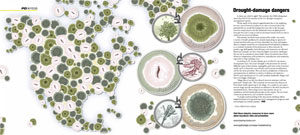Is there any relief in sight? This summer the USDA designated more than half of all counties in the U.S. drought emergency management regions. While much of the nation’s apprehension lies in the depleting harvest, many livestock producers are also concerned about the potential for an unsafe feed supply this year due to the drought. (Click here or on the image at right to view it at full size in a new window.)
Extreme temperatures and the additional stress on plant growth have put this year’s crops at risk for increased nitrate levels as well as mold and mycotoxin problems.
Mycotoxins, harmful toxins produced by molds, can create a variety of health problems for animals depending on species of animal involved and type of toxins identified. In swine and equine, there is a higher sensitivity to contaminated feed and feed avoidance is a common symptom of mycotoxicoses in these animals.
In poultry, egg shell quality, feed efficiency and immunity are affected. Ruminant animals can bear relatively higher mycotoxin challenges but are not as resistant as many think. Many mycotoxins have been shown to compromise milk production, reproduction and immunity, especially in high-yielding cows.
According to Dr. Swamy Haladi, part of Alltech’s mycotoxin management team, this year’s drought is the precursor for several different types of mycotoxins. Aspergillus and some of the Fusarium molds, such as Fusarium verticilloides and Fusarium proliferatum , will be the most prevalent.
This can lead to production of aflatoxins and fumonisins in addition to routine incidences of vomitoxin (DON) and zearalenone in U.S. and Canadian feedstuffs. Silages will have even bigger challenges.
“Silage that is too dry, less than 65 percent moisture, will not pack well,” Haladi said. “This situation can increase the chances of Penicillum molds appearing in our silage. As a result we can expect several silage-specific mycotoxins in addition to the field mycotoxins mentioned above.
These silage-borne mycotoxins can act as antibiotics and kill beneficial microbes in the rumen. The net result is lowered productivity and metabolic disorders.”
“A proper understanding of the mycotoxin challenge allows implementation of integrated mycotoxin management programs and technologies in a timely manner.” PD
—From Alltech news release
Click here and/or here to learn more about mycotoxin risks and prevention.


.jpg?t=1658551847&width=640)

